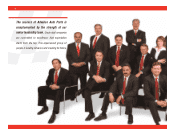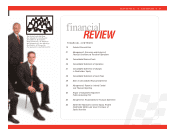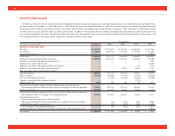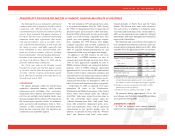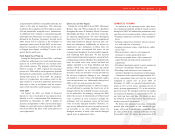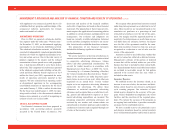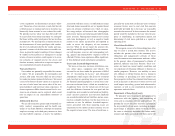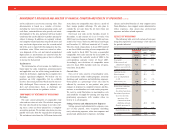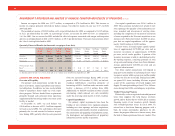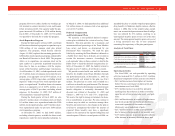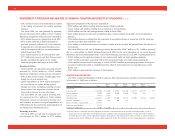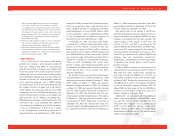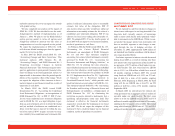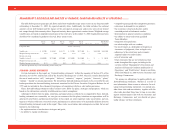Advance Auto Parts 2005 Annual Report Download - page 27
Download and view the complete annual report
Please find page 27 of the 2005 Advance Auto Parts annual report below. You can navigate through the pages in the report by either clicking on the pages listed below, or by using the keyword search tool below to find specific information within the annual report.
Advance Auto Parts
I
Annual Report 2005
I
25
of the liquidation of discontinued inventory below
cost. The nature of our inventory is such that the risk
of obsolescence is minimal and excess inventory has
historically been returned to our vendors for credit.
We provide reserves where less than full credit will
be received for such returns and where we anticipate
that items will be sold at retail prices that are less than
recorded cost. We develop these estimates based on
the determination of return privileges with vendors,
the level of credit provided by the vendor and man-
agement’s estimate of the discounts to recorded cost,
if any, required by market conditions. Future changes
by vendors in their policies or willingness to accept
returns of excess inventory could require us to revise
our estimates of required reserves for excess and
obsolete inventory and result in a negative impact on
our consolidated statement of operations.
Warranty Reserves
Our vendors are primarily responsible for warran-
ty claims. We are responsible for merchandise and
services sold under warranty which are not covered
by vendor warranties (primarily batteries). We record
a reserve for future warranty claims as an increase in
our cost of sales based on current sales of the war-
ranted products and historical claim experience. If
claims experience differs from historical levels, revi-
sions in our estimates may be required, which could
have an impact on our consolidated statement of
operations.
Self-Insured Reserves
We are self-insured for general and automobile lia-
bility, workers’ compensation and the health care
claims of our Team Members, although we maintain
stop-loss coverage with third-party insurers to limit
our total liability exposure. A reserve for liabilities
associated with these losses is established for claims
filed and claims incurred but not yet reported based
upon our estimate of ultimate cost, which we calcu-
late using analyses of historical data, demographic
and severity factors and valuations provided by third-
party actuaries. Management monitors new claims
and claim development as well as negative trends
related to the claims incurred but not reported in
order to assess the adequacy of our insurance
reserves. While we do not expect the amounts ulti-
mately paid to differ significantly from our estimates,
our self-insurance reserves and corresponding sell-
ing, general and administrative expenses could be
affected if future claim experience differs significant-
ly from historical trends and actuarial assumptions.
Leases and Leasehold Improvements
We lease certain store locations, distribution cen-
ters, office space, equipment and vehicles. We
account for our leases under the provisions of SFAS
No. 13, “Accounting for Leases,” and subsequent
amendments which require that leases be evaluated
and classified as operating leases or capital leases
for financial reporting purposes. Certain leases con-
tain rent escalation clauses, which are recorded on a
straight-line basis over the initial term of the lease
with the difference between the rent paid and the
straight-line rent recorded as a deferred rent liability.
Lease incentive payments received from landlords
are recorded as deferred rent liabilities and are amor-
tized on a straight-line basis over the lease term as a
reduction in rent. In addition, leasehold improve-
ments associated with these operating leases are
amortized over the shorter of their economic lives or
the respective lease terms. The term of each lease is
generally the initial term of the lease unless external
economic factors were to exist such that renewals
potentially provided for in the lease are reasonably
assured to be exercised. In those instances the renewal
period would be included in the lease term for pur-
poses of establishing an amortization period and
determining if such lease qualified as a capital or
operating lease.
Closed Store Liabilities
We recognize a reserve for future obligations at the
time we close a leased store location. The reserve
includes the present value of the remaining lease
obligations and management’s estimate of future
costs for common area maintenance and taxes, offset
by the present value of management’s estimate of
potential subleases and lease buyouts. These esti-
mates are based on current market conditions and
our experience of obtaining subleases or buyouts on
similar properties. However, our inability to enter
into subleases or obtain buyouts due to a change in
the economy or prevailing real estate markets for
these properties within the estimated timeframe may
result in increases or decreases to these reserves and
could impact our selling, general and administrative
expenses, as well as our consolidated statement of
operations and cash flows.
Impairment of Long-Lived Assets
We primarily invest in property and equipment in
connection with the opening and remodeling of
stores and in computer software and hardware. We
periodically review our store locations and estimate
the recoverability of our assets, recording an impair-
ment charge, if necessary, when we decide to close
the store or otherwise determine that future undis-
counted cash flows associated with those assets will



